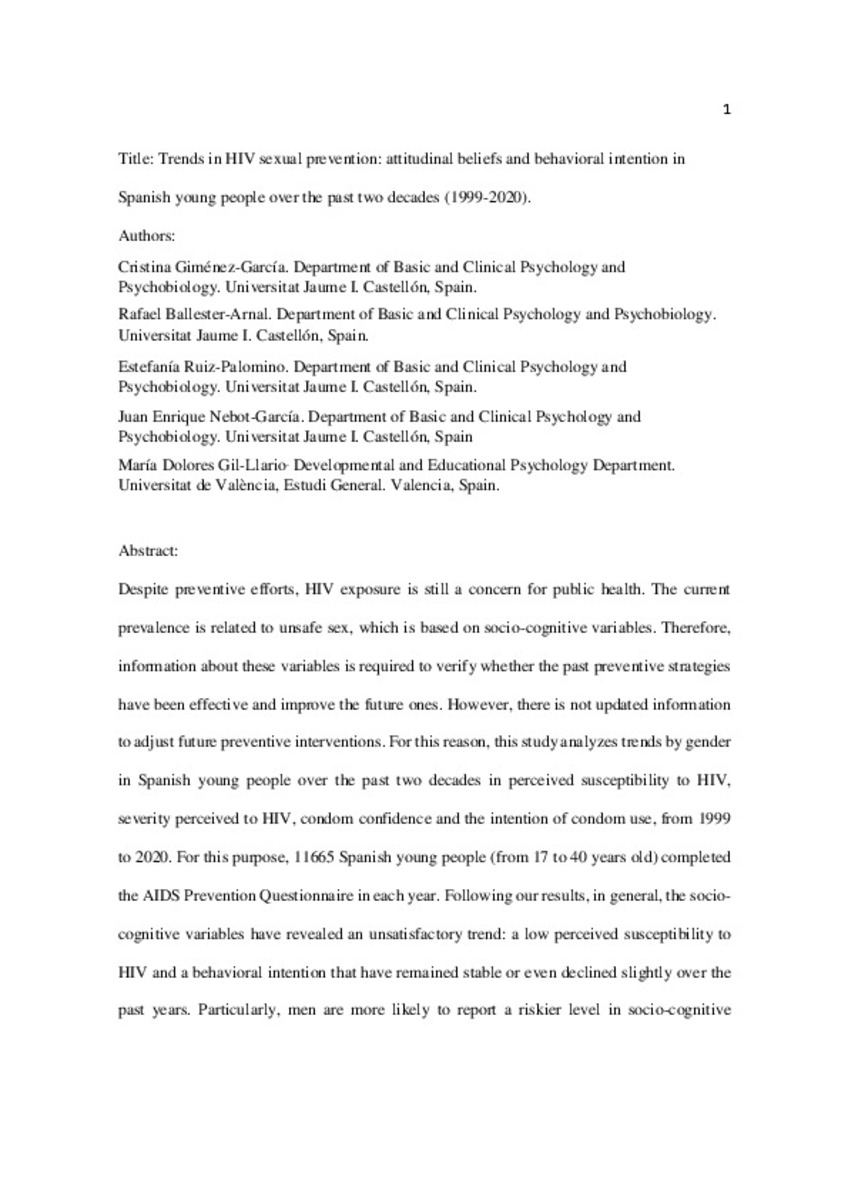Mostrar el registro sencillo del ítem
Trends in HIV sexual prevention: Attitudinal beliefs and behavioral intention in Spanish young people over the past two decades (1999-2020)
| dc.contributor.author | Giménez-García, Cristina | |
| dc.contributor.author | Ballester-Arnal, Rafael | |
| dc.contributor.author | Ruiz-Palomino, Estefania | |
| dc.contributor.author | Nebot-Garcia, Juan Enrique | |
| dc.contributor.author | Gil-Llario, MD | |
| dc.date.accessioned | 2022-02-07T15:44:43Z | |
| dc.date.available | 2022-02-07T15:44:43Z | |
| dc.date.issued | 2022-03-01 | |
| dc.identifier.citation | GIMÉNEZ-GARCÍA, Cristina, et al. Trends in HIV sexual prevention: Attitudinal beliefs and behavioral intention in Spanish young people over the past two decades (1999–2020). Sexual & Reproductive Healthcare, 2022, 31: 100677. | ca_CA |
| dc.identifier.issn | 1877-5756 | |
| dc.identifier.uri | http://hdl.handle.net/10234/196667 | |
| dc.description.abstract | Despite preventive efforts, HIV exposure is still a concern for public health. The current prevalence is related to unsafe sex, which is based on socio-cognitive variables. Therefore, information about these variables is required to verify whether the past preventive strategies have been effective and improve the future ones. However, there is not updated information to adjust future preventive interventions. For this reason, this study analyzes trends by gender in Spanish young people over the past two decades in perceived susceptibility to HIV, severity perceived to HIV, condom confidence and the intention of condom use, from 1999 to 2020. For this purpose, 11,665 Spanish young people (from 17 to 40 years old) completed the AIDS Prevention Questionnaire in each year. Following our results, in general, the socio-cognitive variables have revealed an unsatisfactory trend: a low perceived susceptibility to HIV and a behavioral intention that have remained stable or even declined slightly over the past years. Particularly, men are more likely to report a riskier level in socio-cognitive variables although, in the latest evaluations, women would decrease condom use intention largely than men. In general, regarding age, young adult would report better levels of condom confidence, but early youth would get higher results in perceived severity, as well as better scores in the latest evaluations of condom use intention. Considering these results, policies should make an effort in HIV prevention programs, and emphasize the attention to attitudinal beliefs and behavioral intention to improve their effectiveness. | ca_CA |
| dc.format.extent | 28 p. | ca_CA |
| dc.format.mimetype | application/pdf | ca_CA |
| dc.language.iso | eng | ca_CA |
| dc.publisher | Elsevier | ca_CA |
| dc.relation.isPartOf | Sexual & Reproductive Healthcare, 2022, 31: 100677 | ca_CA |
| dc.rights | Copyright © 2021 Elsevier B.V. All rights reserved. | ca_CA |
| dc.rights.uri | http://creativecommons.org/licenses/by-nc-nd/4.0/ | ca_CA |
| dc.subject | attitudinal beliefs | ca_CA |
| dc.subject | condom use intention | ca_CA |
| dc.subject | gender | ca_CA |
| dc.subject | HIV | ca_CA |
| dc.subject | young people | ca_CA |
| dc.title | Trends in HIV sexual prevention: Attitudinal beliefs and behavioral intention in Spanish young people over the past two decades (1999-2020) | ca_CA |
| dc.type | info:eu-repo/semantics/article | ca_CA |
| dc.identifier.doi | https://doi.org/10.1016/j.srhc.2021.100677 | |
| dc.rights.accessRights | info:eu-repo/semantics/openAccess | ca_CA |
| dc.type.version | info:eu-repo/semantics/acceptedVersion | ca_CA |
Ficheros en el ítem
Este ítem aparece en la(s) siguiente(s) colección(ones)
-
PSB_Articles [1312]
Articles de publicacions periòdiques








